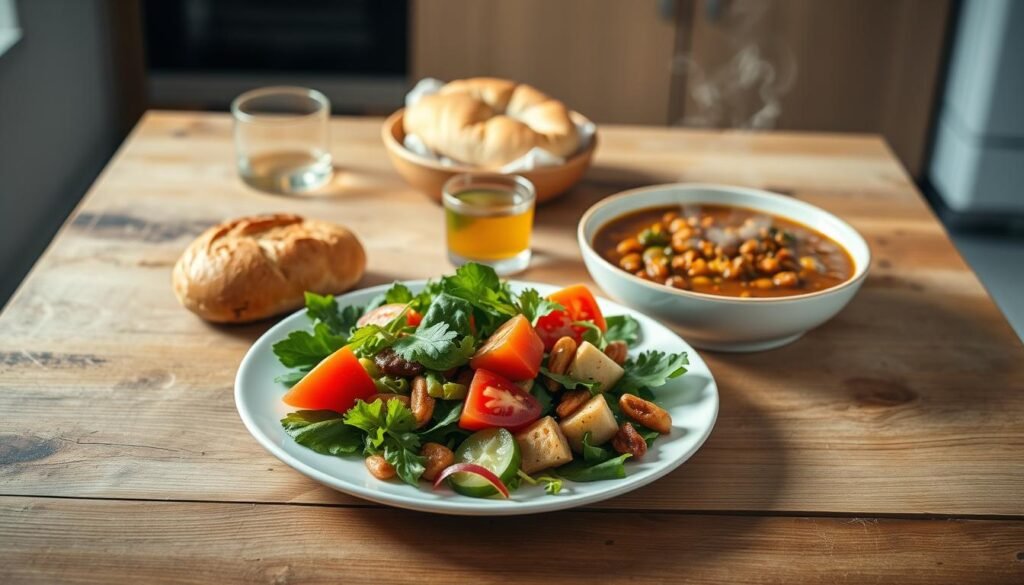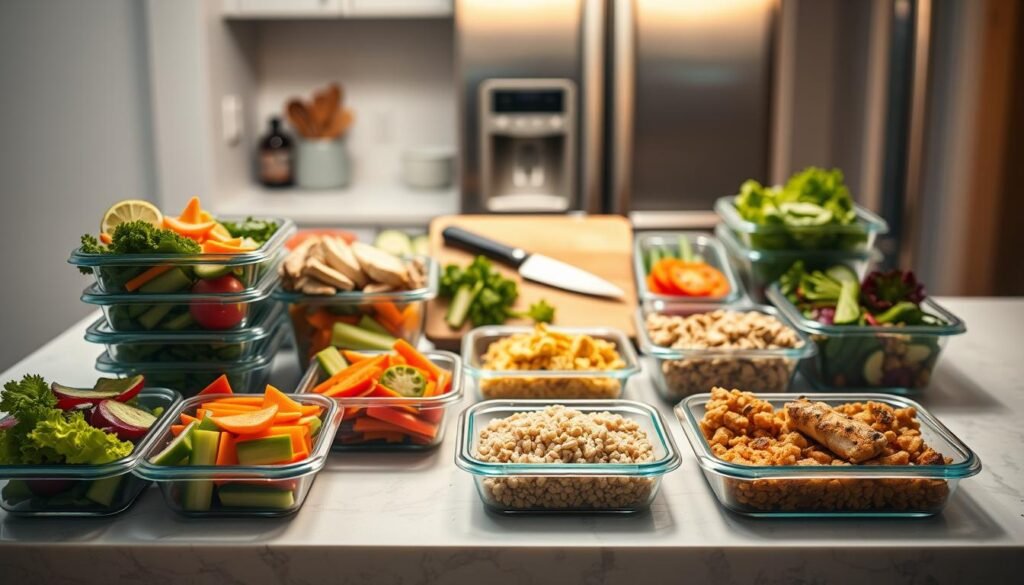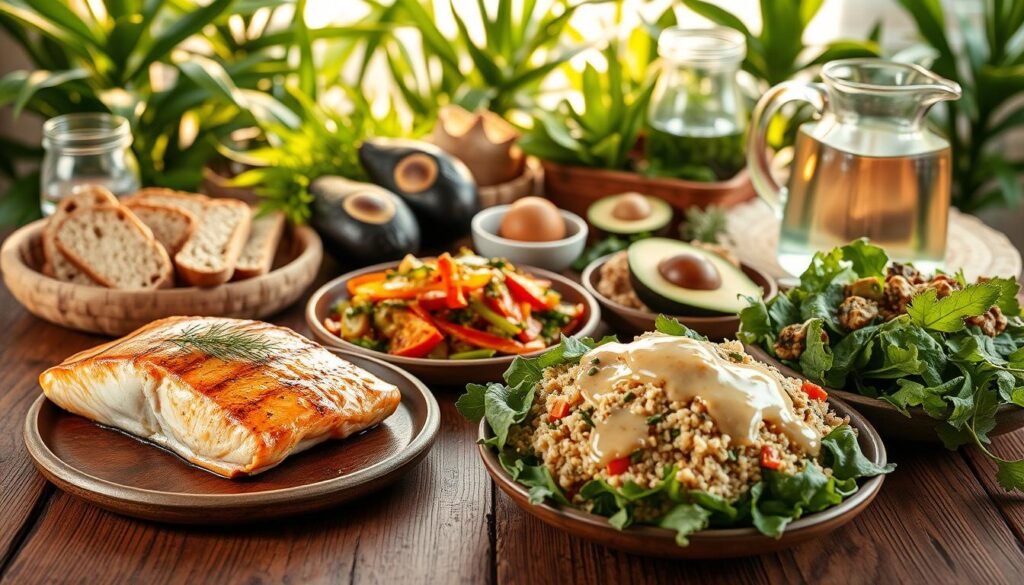It’s easy to make meals that taste great and are good for your heart. These delicious recipes are quick to make and packed with nutrients. They’re perfect for any meal, whether you’re cooking alone or for a big family.
Looking for quick meals? Check out our 25-minute recipes. They’re great for busy nights. You’ll find tasty dishes like seafood bowls and stir-fries that are low in bad fats and salt.
Want to make dinner time more exciting? Let’s explore simple, fresh ingredients that make healthy eating fun.
Key Takeaways
- All recipes align with American Heart Association guidelines for sodium and saturated fat
- Meals can be prepared in 25 minutes or less for time-strapped cooks
- Features creative twists on family favorites like tacos and stir-fries
- Uses accessible ingredients available at most U.S. grocery stores
- Includes options for vegetarian, vegan, and seafood-based diets
1. Benefits of a Heart-Healthy Diet
What you eat affects your heart health. Making small changes can lead to big benefits. A diet full of nutrient-rich foods helps control blood pressure and cholesterol levels. It also keeps your arteries flexible.
Understanding Heart Health
Your heart pumps over 2,000 gallons of blood every day. Foods like spinach and bananas help balance sodium levels. Omega-3 fatty acids from fish also reduce inflammation.
Switching from processed snacks to nuts can lower bad cholesterol by up to 10% in six weeks.
Reducing the Risk of Heart Disease
Too much sodium and saturated fats can harm your heart. The American Heart Association says most U.S. adults eat too much salt. This can make arteries stiff over time.
Here’s how to fight back:
- Read labels: Aim for under 1,500mg sodium daily
- Replace butter with avocado in sandwiches
- Choose skinless poultry over red meat twice weekly
| Dietary Choice | Impact on Heart | Long-Term Benefit |
|---|---|---|
| High sodium intake | ↑ Blood pressure | Increased stroke risk |
| Omega-3 rich foods | ↓ Inflammation | Healthier blood vessels |
| Whole grains daily | Balanced cholesterol | 25% lower heart disease risk |
Pro tip: Use garlic and rosemary instead of salt to flavor roasted vegetables. This simple switch cuts sodium while boosting antioxidants that protect artery walls.
2. Key Ingredients for Heart-Healthy Meals
Creating a heart-healthy diet menu begins with choosing the right ingredients. Fill your kitchen with items like quinoa, farro, and walnuts. Also, learn to replace processed foods with fresh ones. Here are the key ingredients that make meals both tasty and healthy.
Whole Grains to Incorporate
Switch from refined carbs to whole grains that keep blood sugar stable. Here are some good options:
- Quinoa: Complete protein source with all 9 essential amino acids
- Farro: Chewy ancient grain packed with magnesium
- Oats: Beta-glucan fiber helps lower LDL cholesterol
| Grain | Fiber (per cup) | Key Benefit |
|---|---|---|
| Brown Rice | 3.5g | Rich in selenium |
| Barley | 6g | Supports gut health |
| Bulgur | 8g | Quick cooking time |
Lean Proteins for Nutrition
Choose proteins that are low in saturated fat. Opt for skinless poultry, fish, and plant-based options. They provide nutrients without extra calories:
- Grilled chicken breast (marinate in lemon juice + rosemary)
- Wild-caught salmon (omega-3 powerhouse)
- Lentils (1 cup = 18g protein)
Healthy Fats: What You Need
Not all fats are good for your heart. Focus on these healthy fats:
| Fat Source | Serving Size | Best Uses |
|---|---|---|
| Avocado | 1/4 medium | Salads, toast, smoothies |
| Walnuts | 1 oz (14 halves) | Snacking, yogurt topping |
| Olive Oil | 1 tbsp | Low-heat cooking, dressings |
Use citrus zest or garlic instead of salt to avoid hidden sodium. Did you know? Replacing 5% of saturated fats with walnuts can cut heart disease risk by 25% (American Heart Association).
3. Flavorful Fish Recipes
Fish dishes are great for heart health. They are full of omega-3 fatty acids and lean protein. Here are two easy heart-healthy dinner recipes that make delicious meals with simple ingredients.

Grilled Salmon with Lemon
This recipe is quick, taking just 20 minutes. It uses a bright marinade to make salmon even better. You’ll need:
- 4 salmon fillets (6 oz each)
- 3 tbsp olive oil
- 2 minced garlic cloves
- 1 tbsp fresh dill
- 1 lemon (sliced)
First, mix olive oil, garlic, and dill in a bowl. Then, brush this mixture on the salmon. Grill for 5–7 minutes on each side. Finish with lemon slices for a zesty finish.
“Grilled salmon is a powerhouse meal. Its omega-3 content supports cardiovascular health while keeping calories in check.”
Baked Cod with Herbs
Cod gets a flavor boost from an herbed crust. This low-mercury fish is perfect for weekly meals:
- Preheat oven to 400°F
- Mix ½ cup panko breadcrumbs with 1 tsp each of thyme, rosemary, and parsley
- Press mixture onto 4 cod fillets
- Bake for 12–15 minutes
The crispy coating adds texture without extra sodium or fat. Serve with steamed veggies for a balanced meal.
| Fish Type | Omega-3 Content | Cooking Time | Key Benefit |
|---|---|---|---|
| Salmon | 2.3g per 3 oz | 14 mins | Supports brain health |
| Cod | 0.2g per 3 oz | 15 mins | Low in mercury |
4. Tasty Chicken Dishes
Chicken dishes are perfect for making delicious heart-healthy meals that taste great. You can make simple chicken into fancy meals with the right cooking and ingredients. Here are two recipes that are good for your heart and taste amazing.
Lemon Garlic Chicken Thighs
This recipe uses avocado oil for cooking at high heat. Avocado oil doesn’t burn easily, keeping your food safe. The lemon and garlic marinade makes the chicken juicy and flavorful.
“Using avocado oil instead of butter cuts saturated fat by 40% while maintaining rich flavor.”
Preheat your oven to 375°F. Cook the chicken for 20 minutes until it’s fully cooked. Serve it with roasted asparagus for a meal full of vitamins.
Spinach and Feta Stuffed Chicken Breast
This recipe adds a Mediterranean twist to chicken breasts. Mix spinach, feta, and sun-dried tomatoes for extra nutrients. Make holes in the chicken, fill them, and close with toothpicks.
First, pan-fry the chicken in olive oil for 3 minutes on each side. Then, bake it until it’s done. This way, you get a juicy chicken with lots of nutrients. Serve it with quinoa pilaf for more fiber.
These recipes show that delicious heart-healthy meals are easy to make. By choosing lean chicken and adding tasty flavors, you can make dishes that are good for your heart.
5. Wholesome Plant-Based Options
Plant-based meals don’t mean you have to give up taste or nutrition. These low-fat dinner options are full of protein, fiber, and antioxidants. They’re great for vegans or anyone looking to try meatless meals. These recipes focus on keeping your heart healthy.
Lentil and Vegetable Stew
This stew is packed with lentils, diced tomatoes, and fresh kale. Lentils have 18g of plant-based protein per cup. Kale adds vitamins A and C. Add garlic, cumin, and paprika for a smoky flavor. Serve it over brown rice for extra fiber.
Why it works:
- Tomatoes provide lycopene, linked to lower heart disease risk
- Kale’s antioxidants fight inflammation
- Lentils offer 15g of fiber per serving
Quinoa Salad with Roasted Vegetables
Roast zucchini, bell peppers, and red onions until they’re caramelized. Then, mix them with fluffy quinoa. A tangy balsamic dressing made with olive oil and Dijon mustard brings it all together. This salad is great for meal prep because it stays fresh for days.
Key benefits:
- Quinoa contains all nine essential amino acids
- Roasted veggies retain more nutrients than boiled ones
- Balsamic vinegar aids blood sugar control
Both recipes can be made in under 45 minutes. They show that plant-based eating can be easy, enjoyable, and good for your heart.
6. Easy Vegetarian Meals
Looking for simple heart-healthy recipes that save time? These vegetarian dinners are quick, tasty, and good for your heart. They’re perfect for busy weeknights and use common ingredients and shortcuts.

Chickpea Stir-Fry with Broccoli
This stir-fry is packed with protein and fiber. It uses frozen veggies and chickpeas to make a nutritious meal. Here’s how to make it:
- 1 can chickpeas (drained)
- 3 cups frozen stir-fry vegetables
- 2 tbsp low-sodium soy sauce
- 1 tsp sesame oil
- Heat oil in a skillet over medium-high
- Add chickpeas and veggies, cook 8 minutes
- Toss with soy sauce and serve over brown rice
Black Bean Tacos with Avocado Cream
These tacos are a healthier alternative to traditional ones. They use black beans and avocado yogurt sauce. Whole-grain tortillas make them heart-healthy.
- 1 cup mashed black beans
- 6 small whole-wheat tortillas
- 1 ripe avocado
- ½ cup plain Greek yogurt
- Blend avocado and yogurt until smooth
- Warm tortillas and spread with beans
- Top with shredded cabbage and avocado cream
| Feature | Chickpea Stir-Fry | Black Bean Tacos |
|---|---|---|
| Prep Time | 25 minutes | 20 minutes |
| Key Ingredient | Frozen vegetables | Avocado yogurt sauce |
| Heart Benefit | Reduces LDL cholesterol | Lowers blood pressure |
These meals show that simple heart-healthy recipes don’t need fancy ingredients. Keep canned beans and frozen veggies ready for quick dinners. Add walnuts or pumpkin seeds for extra nutrition.
7. Satisfying Whole Grain Pasta Dishes
Craving pasta but want to keep it heart-smart? Whole grain noodles are full of fiber and nutrients. They’re great for quick heart-healthy meals. You don’t need heavy sauces or processed ingredients for tasty dinners that are good for your heart.
Whole Wheat Spaghetti with Pesto
Try whole wheat spaghetti for more fiber in your meal. The dish’s star is a fresh pesto. It’s made with basil, pine nuts, and olive oil, all packed with antioxidants and healthy fats.
Add cherry tomatoes and arugula for extra vitamins. You’ll have dinner ready in 20 minutes.
Three steps to perfection:
- Blend 2 cups basil, ¼ cup pine nuts, and 3 garlic cloves
- Slowly drizzle in ½ cup olive oil while blending
- Mix with cooked pasta and fresh veggies
Quinoa Pasta Primavera
Quinoa pasta is a complete plant-based protein and keeps carbs low. This dish is filled with zucchini, snap peas, and roasted red peppers. It’s tossed in a light lemon dressing and topped with Parmesan for a savory touch without too much sodium.
Pro tip: Double the recipe and refrigerate leftovers for tomorrow’s lunch. The flavors get better overnight, and the noodles stay perfect when reheated.
8. Nutritious Soups for Dinner
Nothing beats a warm bowl of soup on a weeknight. These recipes use fresh ingredients and skip heavy creams and salty broths. They support heart health. For more ideas, check out this healthy soup recipe collection.
Tomato Basil Soup with a Twist
This classic soup gets a healthy makeover. It uses Greek yogurt instead of heavy cream for protein and fewer calories. Roasted garlic and fresh basil add flavor, while balsamic vinegar balances the sweetness of tomatoes. Add whole-grain croutons for extra crunch.
- Key ingredients: Fresh tomatoes, garlic, Greek yogurt, basil
- Prep time: 35 minutes
- Nutrition perks: 12g protein per serving, rich in lycopene
Creamy Cauliflower and White Bean Soup
This soup gets its creamy texture from pureed white beans, not dairy. Turmeric and black pepper add anti-inflammatory benefits. Cauliflower adds fiber. Top it with toasted pumpkin seeds for omega-3s.
- Key ingredients: Cauliflower, cannellini beans, turmeric, vegetable broth
- Prep time: 40 minutes
- Nutrition perks: 15g fiber per bowl, low glycemic index
| Feature | Tomato Basil Soup | Cauliflower Bean Soup |
|---|---|---|
| Creaminess Source | Greek yogurt | Pureed white beans |
| Protein per Serving | 12g | 10g |
| Prep Advantage | Freezes well | Meal-prep friendly |
Both soups keep well in the fridge for up to 4 days. For more heart health, use low-sodium broth and fresh herbs. These recipes show you can have rich flavors without unhealthy additives.
9. Quick and Healthy Stir-Fry Ideas
Make your weeknights better with these fast, heart-healthy stir-fry recipes. They’re great for using fresh or frozen ingredients. This saves time without losing flavor or nutrition. Plus, you’ll have dinner ready in under 30 minutes.

Shrimp and Broccoli Stir-Fry
This dish pairs juicy shrimp with crunchy broccoli in a tasty sauce. Use low-sodium soy sauce to keep salt levels down. Add a bit of sesame oil for a rich aroma. Here’s how to make it:
- Sauté shrimp in olive oil until pink (2-3 minutes).
- Add broccoli florets and minced garlic.
- Toss with sauce: soy sauce, rice vinegar, and a hint of honey.
For extra fiber, serve over brown rice. Frozen shrimp is a great choice here. Just thaw it quickly under cold water.
Tofu with Mixed Vegetables
Try crispy tofu with red bell peppers, snap peas, and carrots for a plant-based option. Pressing the tofu first helps it absorb the sauce better. Here’s how to do it:
- Cube firm tofu and pan-fry until golden.
- Stir-fry veggies in avocado oil (high smoke point).
- Mix in a ginger-garlic sauce with a splash of lime.
This recipe has 20g of protein per serving. It’s perfect with frozen stir-fry veggie blends. Add chili flakes for a spicy twist!
10. Creative Salad Combinations
Salads don’t have to be boring. You can make them satisfying main courses with bold flavors and healthy toppings. These mixes offer freshness, texture, and important vitamins and minerals.
Spinach, Strawberry, and Walnut Salad
This salad combines baby spinach, juicy strawberries, and crunchy walnuts. Strawberries add sweetness and vitamin C. Walnuts bring omega-3 fatty acids for heart health. Finish with balsamic vinaigrette for a tangy taste.
Add grilled chicken or quinoa to make it a full meal. The greens are fiber-rich, keeping you full. It’s great for warm evenings or packed lunches.
Kale Caesar Salad with Chickpeas
Use a lighter Greek yogurt Caesar dressing with lemon and garlic. Massaged kale gets tender, and roasted chickpeas add plant-based protein and crunch. Sprinkle Parmesan for extra flavor.
This version is low in calories but full of taste. Chickpeas boost fiber for better digestion and blood sugar control. It’s perfect for nutritious dinner ideas that feel like treats.
Both salads show that healthy eating can be fun. Try new ingredients or dressings to keep your meals exciting and heart-healthy.
11. Delicious Side Dishes to Complement
A heart-healthy meal needs sides for texture, flavor, and nutrients. These low-fat dinner options keep your plate balanced. They also watch out for sodium and saturated fats. Let’s look at two great recipes that go well with fish, chicken, or plant-based dishes.
Roasted Brussels Sprouts
Make Brussels sprouts crispy and savory. Mix them with olive oil, minced garlic, and smoked paprika. Roast at 400°F for 20-25 minutes until they’re caramelized. You get a side that’s rich in fiber and has zero added salt.
- 6g of dietary fiber per serving
- Antioxidants from garlic and paprika
- Only 90 calories per cup
Quinoa Pilaf with Herbs
Choose quinoa over white rice for more protein. Cook it in low-sodium vegetable broth. Then, mix in fresh parsley, lemon zest, and toasted pine nuts. This pilaf is packed with:
- 8g of plant-based protein per serving
- Heart-healthy monounsaturated fats from nuts
- Bright citrus flavor without heavy dressings
| Side Dish | Prep Time | Key Nutrients | Flavor Boosters |
|---|---|---|---|
| Roasted Brussels Sprouts | 30 mins | Fiber, Vitamin C | Garlic, Paprika |
| Quinoa Pilaf | 25 mins | Protein, Iron | Lemon Zest, Parsley |
These recipes pair well with low-fat dinner options like grilled salmon or lemon garlic chicken. Their strong flavors make you forget about butter or salt. This is great for keeping your heart healthy.
12. Meal Prep Tips for Heart-Healthy Eating
Streamlining your meal prep routine makes sticking to a heart-healthy diet menu effortless. With smart strategies, you’ll save time while keeping meals fresh, flavorful, and packed with nutrients.

Planning Your Weekly Menu
Start by choosing 3-4 recipes that share ingredients to minimize waste. Batch-cook versatile bases like quinoa or grilled chicken breasts. These can transform into salads, stir-fries, or grain bowls throughout the week.
Use this simple template for balanced meals:
- Proteins: Salmon, skinless turkey, or lentils
- Grains: Brown rice, farro, or whole-wheat couscous
- Veggies: Pre-chopped broccoli, bell peppers, or leafy greens
Storing and Reheating Leftovers
Portion meals in glass containers with compartments to prevent sogginess. For soups, leave 1-inch headspace when freezing to allow expansion. Label containers with dates to track freshness.
Revive grains by sprinkling water before microwaving. Cover with a damp paper towel and heat in 30-second intervals. This restores moisture without turning them mushy.
| Food | Fridge Storage | Freezer Storage |
|---|---|---|
| Cooked Fish | 2 days | Not recommended |
| Vegetable Soup | 4 days | 3 months |
| Whole Grain Pasta | 5 days | 2 months |
13. Incorporating Spices for Flavor
Spices do more than add heat or color to food. They’re key to boosting heart health. By choosing antioxidant-rich seasonings over salt, you reduce sodium and enhance taste. Let’s dive into how to use spices to make dishes that are both flavorful and good for you.
Heart-Healthy Seasoning Tips
First, get rid of the salt shaker. Cut down on packaged seasoning mixes, which often have too much sodium. Instead, create your own blends with fresh or dried herbs. Here are some ideas:
- Mix smoked paprika, garlic powder, and black pepper for smoky roasted veggies
- Combine turmeric, cumin, and coriander for warm, earthy notes in soups
- Blend rosemary, thyme, and orange zest for citrusy grilled proteins
Toasting whole spices like fennel seeds or mustard seeds in a dry pan before grinding releases deeper flavors. This method lets you use less seasoning but get more taste.
Best Spices for a Healthy Heart
These five spices offer great flavor and health benefits:
- Turmeric: Curcumin fights inflammation—add to scrambled eggs or rice dishes
- Cinnamon: Helps regulate blood sugar—sprinkle on oatmeal or roasted sweet potatoes
- Ginger: Improves circulation—grate fresh into stir-fries or teas
- Cayenne: Capsaicin boosts metabolism—use sparingly in sauces or rubs
- Oregano: Packed with antioxidants—toss into tomato-based sauces
Keep spices in airtight containers, away from heat, to keep them potent. Replace ground spices every 6-12 months for the best flavor and health benefits.
14. Drinking Wisely: Beverages to Pair
What you drink is key to heart health, alongside your meals. Water is a must, but there are other tasty options. These drinks add flavor without adding sugar or empty calories.
Best Choices for Heart Health
Try unsweetened herbal teas like hibiscus. Studies show they may lower blood pressure. Serve it chilled with lime for a refreshing drink.
For daily hydration, infused waters are great:
- Lemon and cucumber slices
- Strawberries with fresh basil
- Orange wedges and mint leaves
Green tea is also a good choice. Its antioxidants help blood vessels. It pairs well with fish or chicken.
If you like fizz, choose sparkling water with grapefruit juice. It’s better than sugary sodas.
Avoiding Sugary Drinks
Many drinks have hidden sugar. A 12-ounce flavored coffee drink can have up to 45 grams of sugar. That’s almost double the daily limit for most adults.
Be careful of these drinks:
- Sweetened iced teas
- Vitamin-enhanced waters
- Pre-made smoothies
Make healthier versions at home. Use frozen berries and plain Greek yogurt. For a tropical drink, blend unsweetened coconut water with pineapple and spinach. These changes let you control sugar and boost nutrition in your simple heart-healthy recipes.
15. Conclusion: Start Cooking Tonight
You’ve learned how to make meals that are good for your heart. Choose lean proteins like salmon or chicken, and add fiber-rich whole grains and fresh veggies. Use cooking methods like grilling, roasting, or stir-frying to keep nutrients in and add flavor without extra salt or fat.
Recap of Heart-Healthy Choices
Focus on ingredients like olive oil, nuts, and legumes for good fats and plant-based proteins. Try recipes like lemon garlic chicken thighs or quinoa salad with roasted veggies for big flavors with little prep. For fast dinners, check out EatingWell’s 20-minute dinner ideas that are heart-healthy.
Encouragement to Experiment with Recipes
Try two new recipes this week, like shrimp stir-fry and lentil stew. Small changes, like using whole wheat pasta or adding spinach to tacos, can make a big difference. Use spices like turmeric or smoked paprika for flavor instead of heavy sauces.
Your heart health journey begins in the kitchen. With these dinner ideas, you can make meals that are both healthy and delicious. So, grab your apron, pick a recipe, and start enjoying the benefits of cooking with care.
FAQ
What makes a dinner truly heart-healthy?
A heart-healthy dinner focuses on lean proteins like skinless poultry or fatty fish. It also includes whole grains such as quinoa or farro. Plus, it adds colorful vegetables rich in antioxidants. It limits saturated fats, sodium, and processed sugars. Healthy fats like avocado oil or walnuts are also key.
Can I still enjoy pasta on a heart-healthy diet?
Absolutely! Choose whole grain or legume-based pastas like Barilla Whole Wheat Spaghetti or Banza Chickpea Pasta. Pair it with veggie-heavy sauces, such as pesto made with fresh basil and pine nuts. This boosts fiber and nutrient content.
How do I add flavor without salt?
Use citrus zest, garlic, and spices like McCormick turmeric or cumin. Fresh herbs like rosemary or thyme are great. You can also make a salt-free seasoning blend with smoked paprika, onion powder, and black pepper.
Are frozen vegetables as nutritious as fresh for quick meals?
Yes! Brands like Birds Eye Steamfresh frozen broccoli retain nutrients through flash-freezing. They’re perfect for stir-fries or soups, offering convenience without losing heart-healthy benefits.
What’s an easy substitute for heavy cream in soups?
Blend canned white beans or use plain Greek yogurt (like Chobani) for creaminess. Our cauliflower soup recipe uses pureed Great Northern beans. It adds protein and fiber while staying dairy-free.
How often should I eat fish for heart health?
The American Heart Association suggests two 3.5-oz servings weekly of fatty fish like salmon or trout. Try our grilled salmon with lemon-dill marinade or baked cod with herb crust for omega-3 boosts.
Can plant-based meals provide enough protein?
Yes! Combine lentils, chickpeas, or black beans with whole grains. For example, our lentil stew offers 18g of protein per serving. Quinoa salad with roasted veggies provides all nine essential amino acids.
What beverages pair best with heart-healthy dinners?
Choose unsweetened hibiscus tea (like Traditional Medicinals) or infused water with cucumber and mint. Avoid sugary drinks. Opt for sparkling water with a splash of 100% pomegranate juice instead.

